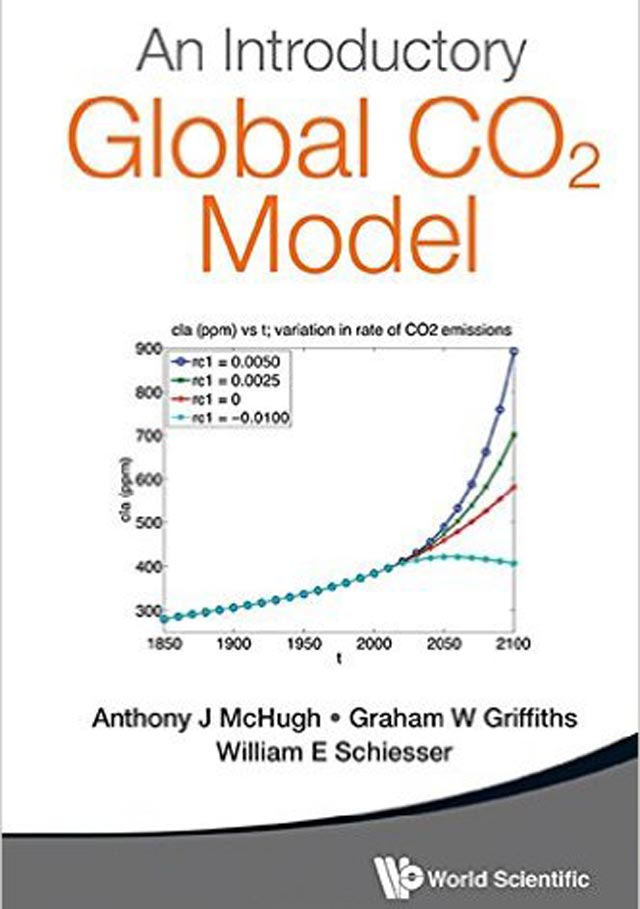“An interconnected, dynamic phenomenon”

A hawksbill sea turtle swims above a coral reef near the Cayman Islands. A new book by Anthony McHugh and William E. Schiesser, and Graham W. Griffiths of City University London, projects that coral reefs, which are composed of calcium carbonate, will be adversely affected by declining pH levels in the world’s oceans. (Photo courtesy of Corbis Images)
In 1896, writing in Philosophical Magazine, a Swedish chemist named Svante Arrhenius became the first scientist to propose that an increase in the amount of carbon dioxide (CO2) in the atmosphere would cause a corresponding increase in the surface temperature of the earth.
Arrhenius wrote an equation for calculating temperature increase based on CO2 levels, later revised it and won the Nobel Prize for chemistry in 1903.
Half a century later, the American scientist Charles Keeling began monitoring CO2levels at the Mauna Loa Observatory in Hawaii and at the South Pole. Keeling concluded that atmospheric CO2 levels could be linked to the quantity of fossil fuels being burned. He created the Keeling Curve, which plots annual CO2 levels at Mauna Loa.
Now, two Lehigh researchers and their British collaborator have written a book dedicated to Arrhenius and Keeling and based on their work. An Introductory Global CO2 Model is scheduled to be published in July by World Scientific Publishing Co.
The book’s authors are Anthony McHugh and William E. Schiesser, professors of chemical and biomolecular engineering at Lehigh, and Graham W. Griffiths of the School of Engineering and Mathematical Sciences at City University London.
Uniformly dispersed
The model described in the book uses ordinary differential equations (ODEs), the software programming languages Matlab and R, and historic and current data to chart the levels of global CO2 distribution from 1850 to 2100 in seven “well-mixed reservoirs”—the upper and lower atmosphere, long- and short-lived biota (plants), the upper and lower layers of the ocean, and the marine biosphere (living marine organisms).
“ODEs have only one independent variable, time,” says Schiesser, “whereas partial differential equations (PDEs) have space and time as independent variables.
“We assume no spatial variation because we view the atmosphere, in regards to CO2, as a mixed volume. Some countries might emit more CO2 than others but everything eventually forms a uniform mixture in the atmosphere.
“All of our model output variables are therefore plotted against only time.”
The result, say Schiesser and McHugh, is a book that should be accessible to students with an elementary knowledge of calculus.
“We’re hoping high school seniors can understand this,” says Schiesser. “We use very basic calculus, which we think they should have studied.”
The authors also believe their text should serve as a useful pedagogical tool for illustrating computer modeling techniques and for quantitatively exploring an issue with important social and environmental implications.
The authors’ model projections show that atmospheric levels of CO2 increased from 280 parts per million in 1850, to 315 ppm in 1958, and to 390 ppm in 2008. Assuming four possible rates of increase in future worldwide CO2 emissions, the model forecasts 2100 atmospheric levels of CO2 rising to 900 ppm with a modest increase in emission rates, 700 ppm with a slower increase, 570 ppm with no increase, and 450 ppm with a modest decline in emission rates.
The increase in atmospheric CO2, the authors say, leads to global warming from the so-called “greenhouse” effect that is trapping energy in the atmosphere that would otherwise be radiated to outer space. The increasing atmospheric temperature in turn, they say, contributes to extreme events such as drought, melting ice and rising sea levels.
A second aspect of the authors’ model charts oceanic pH, a measure of acidity, versus time. It shows a worldwide oceanic pH level of 8.25 in 1850 falling to 8.10 by 2015 and to 7.8 by 2100, with acidity, caused by the hydrogen ions in carbonic acid, rising as pH levels drop. This seemingly small change in pH (from 8.25 to 7.8) actually represents a near tripling of the hydrogen ion concentration in the ocean.
“What we have created is not a climate model but a CO2 model,” says Schiesser. “We have intentionally avoided using the term climate change, which remains controversial. But we think CO2 and climate change are linked.”
A longstanding interest
It was nearly 40 years ago that Schiesser and McHugh began working together to develop mathematical models to describe environmental phenomena, specifically the global distribution of CO2.
Schiesser, now the McCann Professor Emeritus of Chemical and Biomolecular Engineering and also a professor of mathematics, studies numerical methods and software and is author or coauthor of 14 books. McHugh, the Ruth H. and Sam Madrid Professor of Chemical and Biomolecular Engineering, studies polymer science, membrane formation and controlled-release drug delivery.
“Tony got us started in 1976,” said Schiesser. “He showed me a classic paper on CO2 buildup; Keeling was the coauthor. I read the paper and suggested that we put together a model based on Keeling’s paper. We had a grant from the National Science Foundation under its so-called ECOMSETS Program to develop mathematical models to address problems having important social and economic impacts. And that was the beginning of the collaboration that led to this book.
“One of our students did the programming in Fortran. We had workshops here funded by NSF; we presented a model and sent out hundreds of copies on magnetic tape to scientists around the U.S.”
McHugh left Lehigh in 1979 for the University of Illinois in Champaign and returned in 2002 to chair the chemical engineering department. In 2010, McHugh and Schiesser taught several classes in an energy survey course and developed new CO2 models using Matlab and R, two widely used programming languages.
“The students liked the model,” said Schiesser, “so we hit on the idea of writing a book.”
Besides tracking levels of atmospheric CO2 and oceanic pH, the book projects that oceanic levels of calcium carbonate, or CaCO3, are also declining.
“Calcium carbonate is a function of pH,” says McHugh. “It is what coral reefs and the shells of ocean animals are made of. We show, based on chemistry, that calcium is dissolving as pH goes down. And although the decrease may not seem like much, pH is based on a power of 10. So the effect of the lowering of oceanic pH is not linear but exponential. A drop in pH from 8.25 to 8.10 means that the concentration of hydrogen ions, which cause acidity, has increased 1.5 times.”
Quantitative “what if” exercises
Some scientists have maintained, said Schiesser and McHugh, that the capacity of oceans to uptake, or absorb large amounts of CO2 from the atmosphere, would offset the rise in worldwide CO2 emissions.
“We say the oceans are not going to save us,” said Schiesser. “Once CO2 enters the atmosphere, it stays there for centuries even with oceanic uptake.”
The book by Schiesser, McHugh and Griffiths contains exercises that allow readers to enter their own variables and play out “what if” scenarios. For example, if the rate of CO2 emissions doubles, what will atmospheric levels be in 2100? What will oceanic pH be? Or, what needs to be done for carbonic acid levels to drop to a certain level by 2100?
“We’re trying to give people a quantitative procedure they can use to obtain answers to questions about what’s happening now and what will happen in the future,” says McHugh. “The model shows that the global distribution of CO2 is an interconnected, dynamic phenomenon in which the various ‘reservoirs’ act like capacitances for carbon; if you tweak the carbon levels in one reservoir, the others will readjust, but with constants that could take years or even centuries to completely respond.”
In addition to being a primer on carbon modeling, say the authors, the book can serve as a useful introduction to basic scientific programming.
“This is a wonderful tool for learning computer programming,” says McHugh. “You can buy the book just to learn how to do Matlab or how to do R. At the same time, though, it serves as an important introduction to a problem that has a significant impact on the life and health of our global environment.”
The authors have created a website where they will update the information in their book and answer questions from readers.
“We believe in sharing knowledge openly and completely,” says McHugh. “Our website will be a GPS—a global public square—for CO2 issues.”
Posted on:


